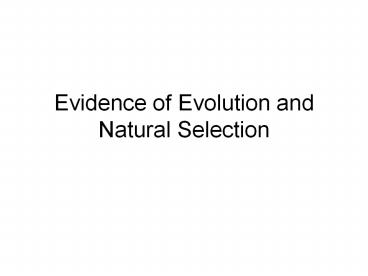Evidence of Evolution and Natural Selection - PowerPoint PPT Presentation
1 / 33
Title:
Evidence of Evolution and Natural Selection
Description:
Evidence of Evolution and Natural Selection Evolution The development of new types of organisms from preexisting types of organisms Evidence of Evolution Short scale ... – PowerPoint PPT presentation
Number of Views:133
Avg rating:3.0/5.0
Title: Evidence of Evolution and Natural Selection
1
Evidence of Evolution and Natural Selection
2
Evolution
- The development of new types of organisms from
preexisting types of organisms
3
Evidence of Evolution
- Short scale of human life makes it hard to
understand evolution - Humans have only been on earth for approximately
200,000 years. - The earth is 4.6 Billion years old
4
A Geologic Calendar is a calendar that places the
entire life of the Earth and places it on a one
year calendar. The formation of Earth would be at
12 midnight, January 1st of the Geologic Calendar
and the current day would be midnight December
31st. To place an event on the calendar, you
divide the date it happened by the age of the
Earth, 4.5 billion years, then multiply that by
365 to find the date and time to include the
event. January 1st, the Earth was formed, and
February 20, the Earth's crust formed. Life began
on March 1st, and our earliest fossils/bacteria
appear on March 26. Land plants didn't appear
until November 4, and fish appeared November 20.
December 11th there was a mass extinction and
December 27 dinosaurs became extinct. Humans
appeared December 31st at around 1156 p.m. and
all recorded human history happened in the last 4
seconds of December 31st.
5
Charles Darwin (English Scientist)
- First published modern evolutionary theory
- (On the Origin of Species by Means of Natural
Selection) - 1831 took a trip around the world
- Stopping everywhere he took different forms of
life - Returned to England with many questions
6
Darwins Voyage
7
(No Transcript)
8
- Adaptations are evidence of evolution
- Look at the picture below. What are some
adaptations of this bass?
9
(No Transcript)
10
Camouflage
- Some species just blend into their environment
11
Bald Eagle
12
(No Transcript)
13
Brown Bear
14
(No Transcript)
15
Structural Features
- Homologous structures
- Structural features with a common evolutionary
origin
16
Homologous Structures
- Salamander, Lizard, Turtle, and Opossum
17
(No Transcript)
18
- Analogous Structures
- Similar in function but do not have a common
evolutionary origin - Look on page 401
- Figure - 15.7
19
(No Transcript)
20
- Vestigial structures
- No present day function but was probably useful
to an ancestor - 60270 on CD
21
Examples of Vestigial Structures
- Eyes on blind mole rats
- Tiny snake pelvic and limb bones
- Humans have a set of muscles for wiggling ears
- Appendix in a human
22
The appendix is about 10 cm in length, but can
range from 2 to 20 cm. The diameter of the
appendix is usually less than 78 mm.
23
- Embryos
- Earliest stage of growth and development in both
plants and animals - Very similar embryos in Fish, Reptiles, Birds,
and Mammals (60271 on CD)
24
Vertebrate Embryos
25
Vertebrate Brains
26
- cerebrum - controls and integrates motor,
sensory, and higher mental functions, such as
thought, reason, emotion, and memory. - Cerebellum - serving to coordinate voluntary
movements, posture, and balance in humans, being
in back of and below the cerebrum and consisting
of two lateral lobes and a central lobe. - Brain Stem - sustaining the basic functions of
life, such as breathing and blood pressure.
27
- Biochemistry
- CAT TAC
- DNA is made of the same building blocks just in a
different order - DNA in a human could be
- AATGGGCCC
- TTACCCGGG
- DNA in a tree could be
- AAGTTTAGC
- TTCAAATCG
28
(No Transcript)
29
- Offspring that survived had certain traits that
were helpful - These organisms then passed down traits to their
offspring - Which leads us to Natural Selection
30
Natural Selection
- Mechanism for change in populations occurs when
organisms with certain variations survive,
reproduce, and pass their variations to the next
generation - http//www.biologycorner.com/worksheets/pepperedmo
th.html
31
Natural Selection
32
Evidence of Evolution
- Adaptations
- Homologous Structures
- Analogous Structures
- Vestigial Structures
- DNA
- Embryos
- Camouflage
33
hominid
Any of various primates of the family Hominidae,
whose only living members are modern humans.
Hominids are characterized by an upright gait,
increased brain size and intelligence compared
with other primates, a flattened face, and
reduction in the size of the teeth and jaw.
Besides the modern species Homo sapiens,
hominids also include extinct species of Homo
(such as H. erectus ) and the extinct genus
Australopithecus. In some classifications, the
family Hominidae also includes the anthropoid
apes.
primate
any of various omnivorous mammals of the order
Primates, comprising the three suborders
Anthropoidea (humans, great apes, gibbons, Old
world monkeys, and New World monkeys), Prosimii
(lemurs, loris, and their allies), and Tarsioidea
(tarsiers), especially distinguished by the use
of hands, varied locomotion, and by complex
flexible behavior involving a high level of
social interaction and cultural adaptability.































